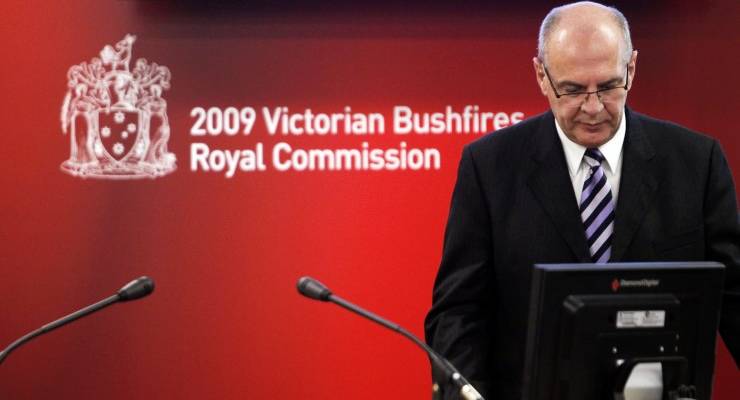
The decision to launch another royal commission into the devastating bushfire season has not come without controversy. It will be expensive and time-consuming, and critics have asked if it will achieve anything new.
It will also be the 58th parliamentary inquiry into bushfires in 80 years — nationally, we’re averaging one inquiry every 14 months.
Crikey takes a look through history to see what — if anything — is different about this one.
Federal approach the only novel aspect
For the first time, this bushfire royal commission will be held at a federal level, formalising the national input into emergency management, which is largely a state-based issue.
This decision has been criticised by many, with Victorian Premier Dan Andrews openly questioning what a federal event could bring to the table. Others have expressed concerns the federal government is expanding its powers.
The uniqueness ends there; just like the 2009 inquiry into Victoria’s Black Saturday, this inquiry will feature commissioners from the defence force and former judges, with only one woman.
Controlled burning a recurring theme
Recommendations from the very first bushfire inquiry in 1939, which examined Victoria’s summer bushfires — one of the worst in Australia’s recorded history — still haven’t been implemented 80 years later.
Kevin Tolhurst, an honorary associate professor in fire and ecology management, says even back then we knew prescribed burning efforts had been inadequate, and there were recommendations calling for an increase.
“We’ve never achieved a level of prescribed burning that would have a measurable effect,” he told Crikey.
Bushfire inquiries into fires across Western Australia in 1961, the eastern seaboard fires in 1994, the Mount Kuring-gai out-of-control hazard-reduction burn in 2000, and a fire across the ACT in 2003 all recommend increased or improved burning planning processes.
The Black Saturday inquiry called for roughly quadruple the amount of controlled burning.
“The fact that it keeps coming up means it hasn’t been addressed,” Tolhurst said.
Climate change addressed — hardly
The terms of reference for this royal commission will include climate change, which is again fairly novel.
The terms state:
The changing global climate carries risks for the Australian environment and Australia’s ability to prevent, mitigate, and respond to bushfires and other natural disasters … Australia as a nation must take action … to address the consequences of longer, hotter, drier seasons and severe weather events.
But that’s about all the attention the topic will get.
According to Tolhurst, climate change “is not going to be looked at. The terms of reference say yes, we accept the climate is changing … it’s mentioned, but there’s no attention to addressing how to reduce climate change.”
It was a similar instance in 2009, where climate change was discussed during the commission for around two hours, though commissioner Bernard Teague later said the topic had been “small beer” for his inquiry because there were no scientists to argue against it.
Not all doom and gloom
Previous inquiries, including the ones into Tasmania’s Black Tuesday in 1967, WA’s fires in 1961, South Australia and Victoria’s Ash Wednesday in 1983, and the 2000 Mount Kuring-Gai bushfire all made reference to the importance of strengthening the coordination of resources and communication.
An inquiry in Victoria in 1944 led to the establishment of the Country Fire Authority, while NSW inquiries across the ’90s prompted the Rural Fire Service to be formed.
Evacuation procedures have changed, too, with greater emphasis on getting out early over staying and protecting property.
But whether it’s a necessary inquiry is still up for debate. Multiple experts have called on governments to implement outstanding recommendations from decades of inquiries, specifically fuel reduction, planning and development issues, and standardised bushfire warnings across states.
In fact, in 2012 a policy on national fire management plan was produced — but still hasn’t been implemented.
“We need to be acting rather than just producing another piece of paper saying what we should be doing,” Tolhurst said.









What was that old saying in the military? Oh, yea, ‘the punishments will continue until morale improves.’ In this case perhaps it is: ‘The inquiries will continue until the answers improve.’ Improve how? By telling us (those who think they know the answers) what we want to hear.
Will this one look into why the findings of previous inquiries have been ignored and who has been responsible for that studied ignorance?
Including the deliberate ignorance of advice from experts such as retired fire chiefs – deliberate, coal-sponsored ideological anti-climate change ignorance that fed this latest catastrophe?
Having heard an interview with Kevin Tolhurst he has some very interesting things to say about fire and land management. Perhaps Crikey could invite Mr Tolhurst to write an article?
Instead of sinking a lazy hundred million into yet another royal commission, producing recommendations 99% of which we already know. Why not go really radical (for Australia) and seed money into swarming fire fighting drones. Imagine a swarm of 500 or 1000 drones, each dropping a kilo of retardant directly on the heart of a fire, then zipping over to a strategically parked semi-trailer for another load. While research has been ongoing overseas for years, I haven’t heard of any in Australia.
From what I understand, this is an oversimplification of Stretton’s conclusions. Didn’t he recommend more strategic prescribed burning, but also conclude that the fires had been caused by way too much uncoordinated burning?
Here’s a slightly different perspective from someone who is much more familiar with this topic than me:
https://twitter.com/phil_zylstra/status/1217561858451763200?lang=en